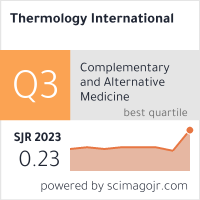American Academy of Thermology
Deutsche Gesellschaft für Thermographie & Regulationsmedizin
European Association of Thermology
Find volumes prior to 2012 in Archive
Infrared thermography assessment of patients with stroke under neuromuscular blockade intervention - A Pilot Study
Artur Cesar Aquino dos Santos1, Fábio Marcon Alfieri1,2, Linamara Rizzo Battistella 1,3
1.Instituto de Medicina Física e de Reabilitaç?o do Hospital das Clínicas da Faculdade de Medicina da Universidade de S?o Paulo
2.Adventist University Center of S?o Paulo - UNASP
3.Faculdade de Medicina FMUSP, Universidade de S?o Paulo, S?o Paulo, SP, Brasil.
INTRODDUCTION: Spasticity, motor sequelae of stroke, can be treated by botulinum toxin type A (BoNT-A) neuromuscular blockade, an intervention that requires follow-up by a trained professional. Infrared thermography can be an alternative for remote assessment of spasticity; however, it is not yet established.
OBJECTIVE: The objective of this study was to demonstrate the association between spasticity and thermo-asymmetry between the plegic and contralateral limbs of patients with stroke treated with BoNT-A.
METHODS: This is a pilot study of eight patients with motor sequelae of stroke. Lower limb spasticity was measured with the Modified Ashworth Scale (MAS) and cutaneous temperature with infrared thermography. The assessments were collected immediately before the intervention and one, two, and three months after BoNT-A application. The variables were analyzed in association by linear regression where the dependent variable was the temperature asymmetry between the lower limbs, and the independent variable was the mean muscle spasticity.
RESULTS: Spasticity and asymmetry of the lower limbs are significantly associated (b=0.39; r²=0.29; p=0.031), and the effect of BoNT-A measured by thermography is more evident in the evaluations of the first and third months. The thermo-asymmetry evolution tends to return to baseline values before spasticity measurements.
CONCLUSION: Changes in lower limb spasticity intensity is associated with cutaneous temperature asymmetry in patients with stroke possibly due to greater blood perfusion after muscle relaxation effect caused by the blockade. Also, future studies should address vascular effects of BoNT-A and confounding variables such as age, BMI, and concomitant treatments.
KEYWORDS: Stroke, spasticity, neuromuscular blockade, body symmetry, thermography.
INFRARROT-THERMOGRAPHISCHE BEURTEILUNG VON SCHLAGANFALLSPATIENTEN NACH NEUROMUSKULÄRER BLOCKADE
EINLEITUNG: Spastik, motorische Folge eines Schlaganfalls, kann durch eine neuromuskuläre Blockade von Botulinumtoxin Typ A (BoNT-A) behandelt werden, eine Intervention, die eine Nachsorge durch eine geschulte Fachkraft erfordert. Die Infrarot-Thermografie kann eine Alternative zur Fernbeurteilung der Spastik sein, ist aber noch nicht etabliert.
ZIEL: Das Ziel dieser Studie war es, den Zusammenhang zwischen Spastik und Thermoasymmetrie zwischen den plegischen und kontralateralen Gliedmaßen von Patienten mit Schlaganfall, die mit BoNT-A behandelt wurden, nachzuweisen.
METHODEN: Es handelt sich um eine Pilotstudie mit acht Patienten, die motorische Folgeerkrankungen nach Schlaganfall boten. Die Spastik der unteren Extremitäten wurde mit der modifizierten Ashworth-Skala (MAS) und die Hauttemperatur mit Infrarot-Thermografie gemessen. Die Bewertungen wurden unmittelbar vor der Intervention und ein, zwei und drei Monate nach der Anwendung von BoNT-A erhoben. Die Variablen wurden in Assoziation mittels linearer Regression analysiert, wobei die abhängige Variable die Temperaturasymmetrie zwischen den unteren Gliedmaßen und die unabhängige Variable die mittlere Muskelspastik war.
ERGEBNISSE: Spastik und Asymmetrie der unteren Extremitäten sind signifikant assoziiert (b=0,39; r²=0,29; p=0,031), und der Effekt von mittels Thermografie gemessenem BoNT-A ist in den Auswertungen des ersten und dritten Monats deutlicher. Die Entwicklung der Thermoasymmetrie tendiert dazu, zu den Ausgangswerten vor den Spastikbeurteilungen zurückzukehren.
SCHLUSSFOLGERUNG: Veränderungen der Intensität der Spastik der unteren Extremitäten sind bei Patienten mit Schlaganfall mit einer Hauttemperaturasymmetrie assoziiert, die möglicherweise auf eine größere Durchblutung nach dem durch die Blockade verursachten Muskelentspannungseffekt zurückzuführen ist. Zukünftige Studien sollten sich auch mit den vaskulären Auswirkungen von BoNT-A und Störvariablen wie Alter, BMI und Begleitbehandlungen befassen.
SCHLÜSSELWÖRTER: Schlaganfall, Spastik, neuromuskuläre Blockade, Körpersymmetrie, Thermografie.
Thermology international 2024, 34(2) 29-35
